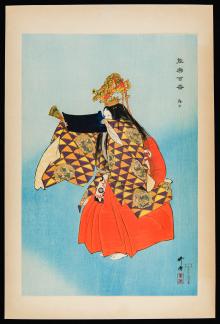Back
Vibrance and Serenity: Art of Japanese Nō Traditional Theatre
TSUKIOKA Kōgyo (1869-1927). Ama (Diver Woman), from the series One Hundred Nō Plays (Nōgaku hyakuban). Japanese; Taishō period, 1922-26. Woodblock print in vertical ōban format; ink and color on paper, 15 x 10 inches. Gift of Elizabeth D. Moyer & Michael C. Powanda, 2017:36.40
Vibrance and Serenity: Art of Japanese Nō Traditional Theatre
August 18, 2018 to October 06, 2019
This installation introduces the history and performance of Nō theater using selected prints by TSUKIOKA Kōgyo (1869-1927) recently donated to the museum by Elizabeth Moyer and Michael Powanda. Established in the fourteenth century, Nō (sometimes spelled Noh) is one of Japan’s oldest and most revered theatrical forms. Taking place on a small square stage with minimal props, it is widely acknowledged, both nationally and internationally, as the epitome of Japanese simplicity and refinement. Kōgyo's prints not only encapsulate the elegance of Nō performance, the beauty of its costumes, and the serenity of its masks, but also the vibrancy and dynamism of Nō drama. The installation also includes examples of other types of Japanese art, including paintings, prints, calligraphy, books, ceramics, lacquer, textiles, armor, dolls, and decorative objects. Co-curated by UO History of Art and Architecture Associate Professor Akiko Walley and JSMA chief curator Anne Rose Kitagawa.






